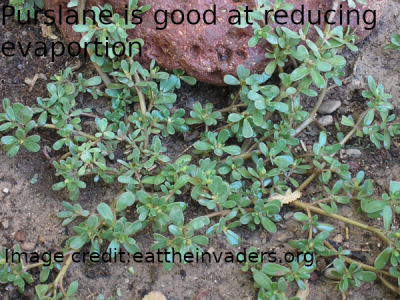Table of content
- Garden bed design
- Soil
- Planted varieties
- How you water
- How you water: With the hose
- How you water: Drip irrigation
- How you water: Let the rain do it
Garden bed design
Different designs of garden beds have different levels of water conservation. Though hugelkultur mounds have lasting fertility they are open allowing for loss of water to evaporation so when trying to conserve water dig a hole to build your hugelkultur beds in to reduce evaporation. When building garden beds on a hill build a large berm on the down hill side of each bed to capture water while it soak into the soil, and try to make them level. Try not to build raised beds because they are higher they are farther from the level at which the soil is moist and will need more frequent watering.
Soil
Make sure your soil has a lot of organic matter because organic matter holds water for plants to adsorb. If your soil is high in silt or clay often water will run off of it instead of soaking in, to fix this add rotting organic matter such as the stocks of the plants you grew last year, the organic matter breaks up the dense structure of the silt and clay allowing water to soak in. If your soil is high in sand you might notice that water tends to run through it leaving the soil to be dry again soon, adding organic matter still helps because the organic matter soaks up water catching it and holding it in the soil.
Planted varieties
If you are having problems with water conservation plant varieties that do not need very much water. Plant the varieties that need more water were the soil often has more water. When growing plants that leave the soil exposed grow other plants that do not need very much nutrient and water that cover the ground to reduce evaporation(for example if you were growing potatoes you could grow purslane or mustard to keep the exposed soil from losing water or eroding). By planting plants that shade the soil and have wider root structure the plant you grow will make more use of the available water. It is good to grow hardy ground covers in the paths between rows in gardens because water evaporates from paths as well and those paths hold water that runs off mounds.
How you water
There are more than tree ways to water but the three main are: 1: to use a garden hose and and sprayer head 2: to use drip line irrigation 3: to let the rain water your plants for you.
How you water: With a hose
When watering with a hose on a open setting that puts down a lot of water fast often soil will wash away which is a loss of nutrients water and water holding capacity, but when watering on a lower setting such as mist or something like that it takes a long time to waster and water will often be lost to the ambient area which is also not good. For these reason I often use a wand which makes a lot of small low pressure stream, or take old milk and other gallon jugs with small holes poked near the bottom to diffuse the water into the soil slowly. Also when watering with a hose try to direct the water at the base of the plant were the roots best make use of it.
How you water: Drip irrigation
Drip irrigation is good at putting the water directly at the base of the plant were it is best used with out disturbing the soil. But drip line and the equipment that goes with it is rather expensive, and it takes a lot of time and effort to set up. If the shape of your garden changes the the drip line will need to be reconfigured taking more time money and effort. Also if your garden is a strange shape or particularly long then the drip line will not water it evenly because the water pressure goes down the farther from the main hose it gets. For instructions to install drip irrigation click here.
How you water: Let the rain do it
Using the rain to water your plants requires that you live were there is regular rain through much of the year and that you plant varieties that do not require very much water. If you design your garden beds optimally it will make easier to go without watering and just let the rain do it for you. You may be able to let the rain water for you early and late in the season when there is more rain and water in the middle of the gardening season when it is hot and dry.
